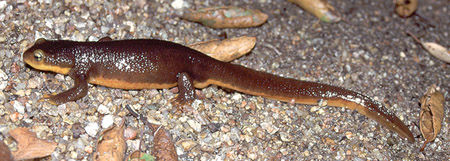- California Newt
Taxobox | name = California Newt
status = LC | status_system = IUCN3.1
trend = unknown

image_width = 240px
regnum =Animalia
phylum =Chordata
classis =Amphibia
ordo =Caudata
familia =Salamandridae
genus = "Taricha "
species = "T. torosa"
binomial = "Taricha torosa"Subspecies
California newts, a species of toxic amphibian living in the United States, are divided into two subspecies:
* Sierra newt ("Taricha torosa sierrae")
* Coastal Range newt ("Taricha torosa torosa"). The difference between these two seems to be only in the location in which the newt is found.Location and Habitat
California newts exist primarily on the California Coastline and in the Sierra Nevada. This is because they prefer less humid climates than the rough skinned newts. During the non-breeding season the newts are land dwelling, preferring rock crevices and logs. While breeding, the subspecies torosa torosa prefers slow moving pools in coastal streams. The California Newt is also referred to as the Oregon or Orange Bellied Newt.
Diet
Earthworms, snails, slugs, sowbugs, bloodworms, mosquito larvae and other invertebrates are among the California newt's prey. In the Sierras, the newt will also consume trout eggs. In an aquarium habitat, the newt will eat and thrive on goldfish flake food.
Breeding
Reproduction occurs generally between December and early May. Typically the adult newts will return to the pool in which they hatched. After a mating dance, the male mounts the female and rubs his chin on her nose. He then attaches a spermatophore to the substrate, which she will retrieve into her cloaca.
The egg mass released by the female contains between 7 and 30 eggs, and is roughly the consistency of a thick gelatin dessert. Typically the egg masses are attached to stream plant roots or to rocky crevices in small, slow moving pools. But they have also been known to be attached to underwater rocks or leaf debris. While shallow in a wide sense, these pools are rather deep relative to the average depth of a Southern California stream, varying in depth from about 1 to 2 meters.
Adult newts will stay in the pools throughout the breeding season, and can be occasionally found well into the summer. Larvae hatch sometime in early to mid summer, depending on local water temperature. Larvae are difficult to find in streams as they blend in well with the sandy bottom, which they usually stay close to.
Toxicity and Predation
Like other Taricha members, the glands in the skin of the torosa secrete the potent neurotoxin
tetrodotoxin , which is hundreds of times more toxic than cyanide. This is the same toxin found in pufferfish and harlequin frogs. Researchers believe that bacteria synthesize tetrodotoxin and the animals that employ the neurotoxin acquire it through consumption of these bacteria. This neurotoxin is so strong that it is enough to kill most vertebrates, including humans. However, they are dangerous only if ingested, and can be safely kept as pets.Due to their toxicity, the California newt has few natural predators. Garter snakes are the most common, and some species have developed a genetic resistance to tetrodotoxin.
Species of Concern
The California Newt is currently a California Special Concern species (DFG-CSC). Some populations have been greatly reduced in southern California coastal streams due to the introduction of non-native, invasive species and human habitation. The mosquitofish ("
Gambusia affinis ") and red swamp crayfish ("Procambarus clarkii ") have caused the greatest reduction in newt populations.Introduced as fish bait and stock pond prey, red swamp crayfish are an incredibly aggressive, prolific, and stalwart species that will prey upon newt larvae and egg masses. The crayfish will also disrupt newt breeding via competition for space during the summer mating season and physically antagonizing adults. Crayfish will typically maul the adult newts with their claws, and subsequent infection can lead to death. California Newts present in streams with introduced crayfish often sport tails with several notches removed. They are amphibians and live in humid areas.
See also
*
Newt
*Salamander
* The genusTaricha
*Rough-Skinned Newt
*Red Bellied Newt
*Salamandridae
*Sierra Newt References
* Database entry includes a range map and justification for why this species is of least concern
External links
* [http://wildanimalsonline.com/amphibians/californianewt.php California Newt facts] - Wild Animals Online encyclopedia
* [http://www.caudata.org/cc/species/Taricha/T_torosa.shtml Caudata Culture] - Guide to identifying and keeping this newt as a pet
Wikimedia Foundation. 2010.
